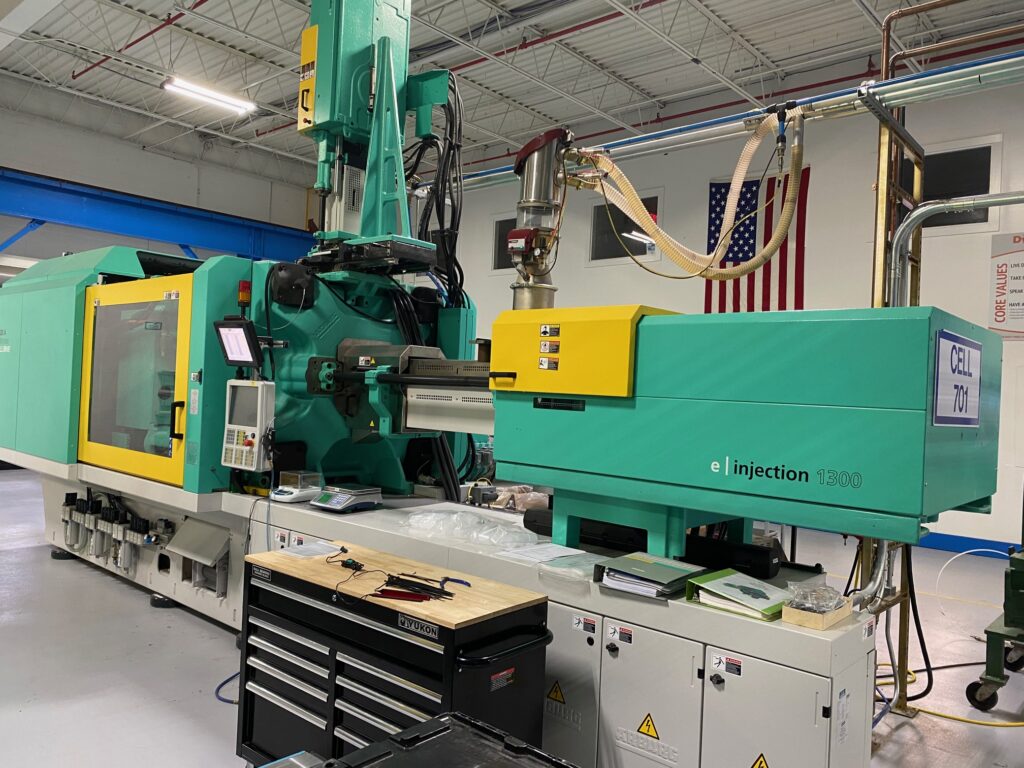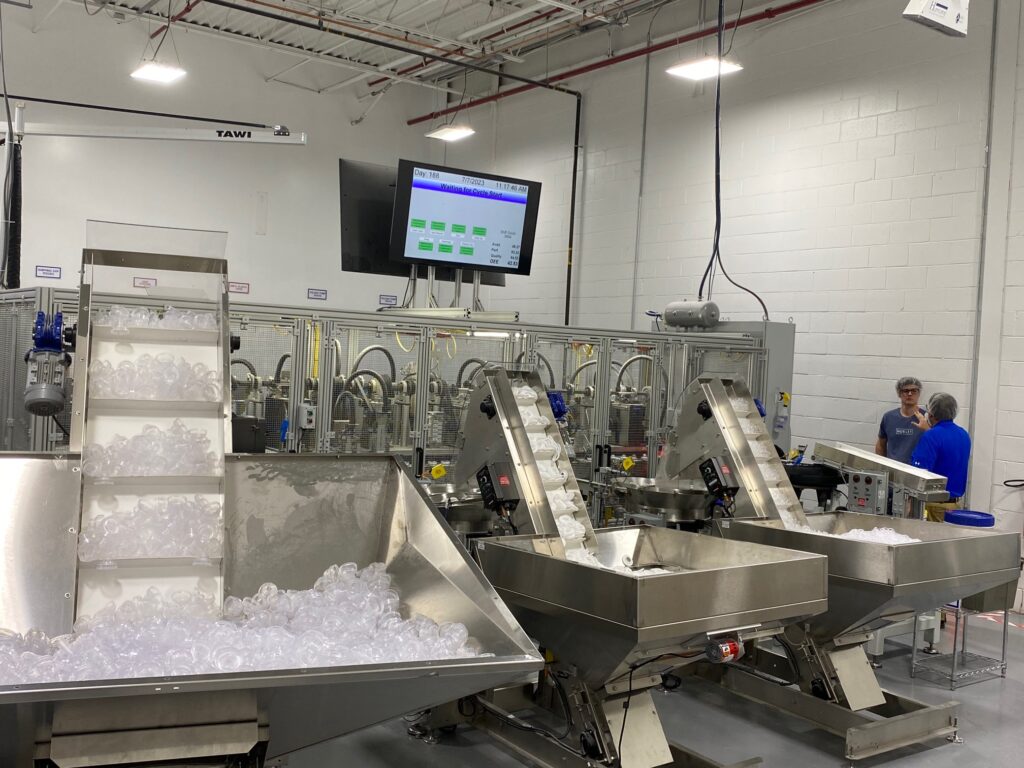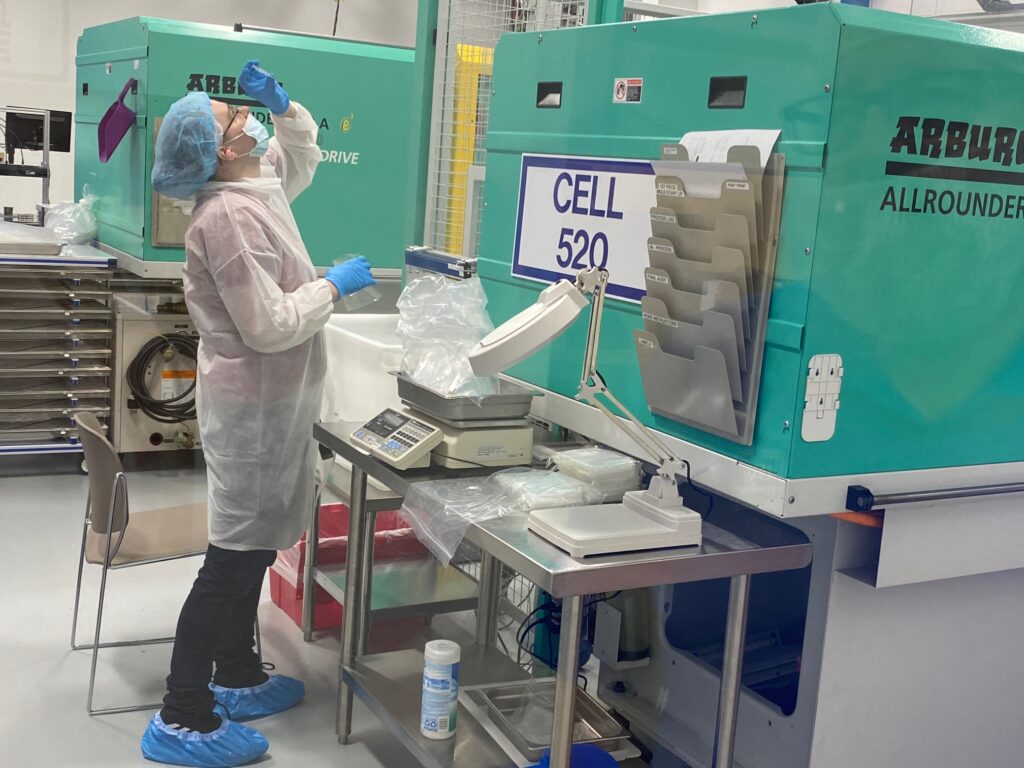Dymotek’s specialties include 2-shot molding and various automated assemblies
By Mark Langlois

This Arburg 550-ton injection, two-shot molding machine is the largest at Dymotek’s Somers, Conn., facility. It enables the company to perform two-shot molding of dissimilar materials. (Photo by Mark Langlois)
Dymotek Corporation, a custom plastics molder headquartered in Ellington, Connecticut, has spent decades honing its expertise in plastics injection molding and liquid silicone rubber (LSR) molding. But the company also specializes in a highly automated process that can combine materials from both techniques to enhance part performance.
That process—2-shot molding—can simplify or eliminate assembly while also producing parts that perform better than single-material parts for certain applications. It does so by carefully controlling “the injection of multiple materials, including two different kinds of resin, into a single, multi-chambered mold,” according to Dymotek’s website.
“We have the ability to engineer multi-material solutions, combining plastic and rubber,” the company’s website said. “Our 2-shot molding process solves assembly problems and reduces assembly operations.”
Two brothers, Steve and Tom Trueb, founded the firm in 1990 in northern Connecticut farm country, starting out making plumbing parts. Today, Dymotek workers enjoy some of the vegetables still grown near the plant. But now, about 90 percent of the company’s parts are sought by the medical, food and beverage, and commercial/industrial markets.
The company still makes plumbing parts, as well as roof vents, parts for surgical equipment, and plastic-and-rubber disposable pumps. Dymotek employs roughly 110 people at two facilities—including one in Somers, Connecticut—that span a total of nearly 85,000 square feet of workspace. It runs more than 30 injection molding presses, ranging in clamp force from 15 to 550 tons, at these facilities, the company said in a release.
Dymotek—short for Dynamic Molding Technologies—operates under a quality management system that is certified to ISO 9001:2015, for non-medical markets, and ISO 13485:2016, for medical markets. Both certifications apply to “molding and assembly of injection molded silicone and thermoplastic components and component assemblies,” according to the company’s registration certificate.
Automation plays key role in molded part assemblies
The company describes its assembly capabilities as a competitive, value-added advantage that makes its operations more efficient and cost-effective. Its goal is to reduce costs by simplifying or eliminating part assembly steps, and automation plays a key role in this effort.
One of the ways Dymotek accomplishes this is through multi-material molding processes, such as 2-shot molding, overmolding, and insert molding. By molding more than one material in a single molding operation, these techniques produce parts with performance characteristics that bypass the need for multiple, assembled parts. According to a release from Dymotek, the company has become “increasingly active in the high-precision field of 2-shot micromolding of both plastic and silicone.”
Dymotek also offers assembly operations such as ultrasonic welding, riveting, heat staking, and adhesive assembly. With the aid of computer-monitored and robotic transfer machines, the company can consider different options for coordinating multiple operations. Its robot-assisted molding and assembly cells are configured in 2-axis through 6-axis movement to address customers’ complex manufacturing requirements, the company’s website said.
The company also prides itself on giving its customers a competitive advantage through engineering and development. Its engineering expertise spans product design, material selection, mold design, pre-production planning, and process engineering.
“Because we work in rubber and plastic, we work on a lot of devices that control air or fluids,” said Victor Morando, chief innovation officer at Dymotek, in an interview with Design-2-Part. That includes a combination plastic-and-rubber music speaker component that contracts or expands as the speaker produces music.
The roof vents that Dymotek produces are also a combination of ABS plastic and silicone rubber, which allows air to flow into the vent as waste flows down and out of the plumbing. The vent blocks sewer gases from entering the building while allowing air in to vent the plumbing system. The company manufactures three sizes, for uses ranging from large commercial buildings down to a single home. In total, Dymotek manufactures almost a million vents a year, Morando said.
The design challenge, he explained, was making the vent robust enough to pass the national and international plumbing standards required for the device, but simple enough for high-volume production. Like many of Dymotek’s products, each valve gets a pressure decay test automatically during assembly and packaging to confirm function, he said.
6-axis robots handle assembly of injection molded pumps
Dymotek injection molds seven parts from six materials that it assembles into disposable pumps for beverage dispensing. The company assembles more than 6 million pumps a year, Morando said.
“I remember many years ago when the sales guy was happy we reached 20,000 a month,” said Morando. The assembly process for this pump requires its own room for the machine and parts. “Now we have capacity to assemble 800,000 a month.”
The pumps are a good example of how automation has benefited Dymotek’s processes. What started as hand assembly of the pumps grew into automated assembly using two ABB 6-axis robots, Morando said.
The ABB system, which still functions as a backup system, could assemble a pump in nine seconds. Although that seemed fast, Dymotek designed and purchased new automated assembly equipment that assembles a pump every two seconds. To design the new assembly equipment, Dymotek wrote a very detailed engineering specification for what would become a 20-foot, multi-bay assembly machine. The company interviewed 10 manufacturers that wanted to build it.
Dymotek narrowed the 10 down to three and asked them to bid the job. Ultimately, the company paid about $1.1 million for the machine. Since installation, Dymotek has changed a few things to improve performance with the help of its automation engineering staff. The machine alerts operators to any problems as it works, and can assemble13,000 pumps in a shift. Its record is about 13,200, Morando said.
“If we mold the parts precisely, it assembles properly and the screens are green,” he said. Automated assembly requires consistent high-quality components. “The visual screens tell the operators how it’s running. If it isn’t feeding properly, green goes to yellow. If it continues, yellow goes to red.”

Dymotek performs automated assembly of pumps used in beverage dispensing. The green screens above the assembly machine signal that all is well in the assembly process. (Photo by Mark Langlois)
Listening to customer is a guiding principle of design
Morando said that one major challenge of the pump came at the start of the design, when Dymotek engineers were documenting the pump performance requirements.. That’s when they learned the pump must remove all of the beverage concentrate from the container. The pump draws the concentrate and water into itself, mixes it, and dispenses it. In this case, the concentrate is the most expensive part of the process.
Dymotek’s design philosophy includes the goal of learning and adapting to each customer’s needs. The company strives to become an asset by functioning as an extension of the customer’s engineering department, an effort driven by its team of about a dozen engineers. Dymotek currently has three project engineers, two quality engineers, two process engineers, four automation engineers, and a tooling and design engineer, Morando told D2P.
“We take the time to understand what the customer really wants,” he said. “It’s dispensing a highly concentrated liquid. We had to listen to what they were really trying to accomplish. It came out that the bag had to be completely empty when it was finished. No one would be happy to see three or four ounces of product not dispensed.” In other words, the customer didn’t want a pump—they wanted a pump that would empty the bag every time.
Morando once appeared at a product trial as an expert witness regarding a plumbing part’s ability to meet national function standards. “The product is covered by national plumbing standards. I ended up an expert witness for the product,” Morando said. “The case related to the product and if it was being properly used.”
Morando said the standard questioned in court was a sensitive air flow test, and the court wanted to know if a plumber could test the product in the field before it was installed.
“It’s a very sensitive test that must be done in a lab environment,” said Morando, who demonstrated the part to the court and how it works. “I had to show them the requirements and show them the test data.”
Morando said the success of that effort demonstrates how well Dymotek communicates with or on behalf of its customers. “Everyone is encouraged to learn all they can about every part they’re working on.”
In many of the injection molding processes employed by Dymotek, runnerless molds reduce waste. By molding silicone rubber and thermoplastic resins to create a single part from two materials, the company can offer advantages in production, performance, and assembly. Those advantages include a strong chemical bond between the two materials. They also include the ability to remove flash at the mold parting line, which reduces material waste, reduces material cost, and lowers labor costs by elimination of assembly.
Molding parts for medical devices
Dymotek molds parts for medical devices in its 1,400-square-foot cleanroom. Morando said plans are underway to double the size of the cleanroom to make way for more work.
One example of a medical part that Dymotek molds in its cleanroom is a tiny ring-shaped component made of plastic and rubber. The ring center opening is sealed with clear liquid silicone rubber in a two-shot process. Surgeons feed micro-surgical devices through a slit in the rubber seal. The rubber seal keeps liquids in the body while the surgeon operates.
This part is manufactured in the cleanroom with an assist from two robots tending an injection molding machine. Each tiny part is molded in groups of eight, with a robot holding up each part for AI-based visual inspection to ensure zero defects. In addition to using robots to tend injection molding machines, Dymotek uses proprietary assembly equipment that it designs and purchases. It also uses other automation equipment to package and ship directly to the customer or the customer’s customer.
“High levels of automation improve quality and consistency,” Morando said. In the case of the medical part, and the dispensing pump, no one touches a part before it is sent to the customer.
Social media provides recruiting boost
These days, recruiting a talented workforce in the rubber and plastics industry is a significant challenge that pushes companies to use all of their creativity and technical savvy. To meet the challenge, Dymotek is leveraging the power of the internet by making use of the LinkedIn social media platform and YouTube videos.
“We decided that we needed to develop a talent funnel, in the same way as one develops a sales funnel of potential customers,” said Dymotek CEO Norm Forest, in a release from the company.
Last year, Dymotek acquired a recruiter’s license on LinkedIn that gives the company “access to specific core features offered by the platform,” Morando said in the release. “This allows us to search for, connect with, and message potential candidates and job seekers.”
The company touts its small size, saying it offers upward mobility for people who work hard and want to advance. It’s an opportunity that Dymotek employees focus on in their video appearances on Youtube.com.
Zachary Kline, 26, joined Dymotek seven months ago after working as a sales administrator at an aerospace processing company. He was working on precision cleaning, coatings, and adhesive bonding of parts with that firm when he went looking for another job, he said in an interview with D2P.
Kline wanted to change jobs, and so he searched the internet. He found Dymotek in Somers and Ellington, both a few towns away. He liked the idea of working in such a critical part of the company, supporting managerial staff and reporting to the controller. His role today is support for new part introduction. His direction will be regular part production.

A Dymotek employee completes quality checks in the company’s cleanroom. (Photo by Mark Langlois)
“I was scrolling through LinkedIn. This piqued my interest, the roles and the location,” Kline said in the interview.
“We can have three active posts at a time,” Morando told D2P. He said that reaching a younger generation of workers, the company’s next talent base, requires communicating through modern technology.
Dymotek posts short videos on Youtube.com, and the series involves brief interviews with workers who found a career at Dymotek. In one video, about 42 seconds long, a worker who started in a direct labor position is now working as the shift lead manufacturer. She said that Dymotek keeps giving her new challenges and opportunities. Another worker said in her video that she started as a temporary machine operator before Dymotek hired her full-time. She now works as a processing technician.
A third interviewed in a video has six years on the job. He started out as a part-time machine operator and now works in quality full-time. Another worker who started as a part-time machine operator now works in process engineering, focusing on 6-axis robots and a wide range of manufacturing automation equipment.
One video is called, “Discover a New Exciting Career in Molding at Dymotek.” Another is called, “Next Level Career – Plastic Injection Molding at Dymotek.” Another is called, “Learn New Skills for Career Success at Dymotek.”
Dymotek recently reported that it hired four people to fill posts in its tooling and quality departments. The company said in the release that it continues to strive to build its bench strength by adding more high-level engineering expertise related to manufacturing, tooling, processing, and quality.
Dymotek said it has been recognized for eight straight years as one of Plastics News’s Best Places to Work. It also earned the publication’s Processor of the Year Award in 2016. “Such contests take time to enter but we’ve found the resulting recognition to be well worth the investment,” said Forest in the release. The firm also has been recognized six times as a Best Place to Work in Connecticut by the Hartford Courant.
Andrea DeForge, Dymotek’s talent acquisition and training coordinator, is prospecting for talent constantly. The company has created multiple channels of potential employees and applies a checklist against all, the release said.
“We then invite promising individuals in to see the company and meet the people here,” Morando said in the release. He frequently gives these candidates personal tours of the company and its plant. “We do this even when we don’t have any current openings. It’s important to network and create personal connections.”
“I even recruit young folks we meet who are working at local restaurants and shops,” said Morando in the release. “If someone impresses us, we pitch them on learning a skill, getting paid, and building a career.”
Dymotek’s YouTube videos, featuring current employees, are viewable at (www.youtube.com/@dymotek-molding). The company said it still has openings to fill, and they are listed at www.dymotek.com/about-dymotek/careers.html.
